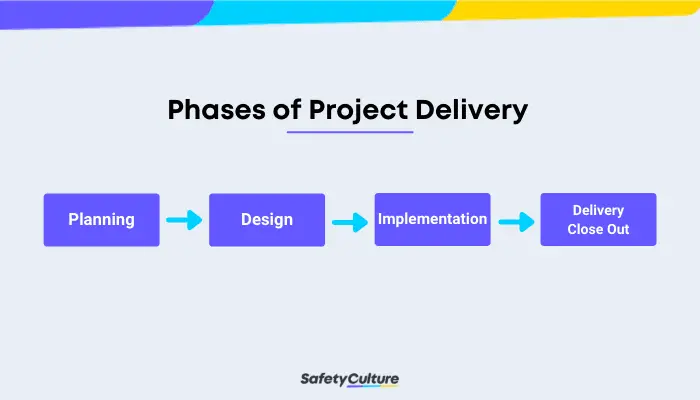What is Project Delivery?
Project delivery refers to the comprehensive process of carrying out and completing projects such as the construction or renovation of a facility or building, among others. It requires careful planning, design, and construction measures from different actors. The project delivery system requires multiple roles, standards, and a defined set of procedures to proceed.
Who is Involved in the Process?
The project delivery system involves the following key actors:
- Project Owner. They are the ones who commission and fund—directly or indirectly—a construction project. They also have the final say in choosing a contractor, delivery method, and other important decisions.
- Designer. Typically an architect or an engineer, they are the primary figure in the design process. They plan the design and look after the construction of the building.
- Contractor. They take care of the daily operations on the construction site. They also hire subcontractors for specific tasks.
- Construction Project Manager. They function as a consultant for the project owner. They manage the schedule and budget for the entire project on behalf of the owner.
Project Delivery Phases
Whether it involves a small-scale facility or a large-scale residential subdivision, every project goes through four phases. Here’s a walkthrough of the stages in delivering a construction project.

Phases of Project Delivery
Planning
Every successful project starts with a solid plan. This project delivery phase involves developing and organizing a strategy for carrying out the project. In this phase, the owner also decides on how the project will proceed from beginning to end.
A comprehensive project plan includes the following elements:
- Goals and objectives
- Project scope
- Stakeholder analysis
- Work plan and breakdown structure
- Communications and reporting structure
- Schedule plan and management
- Risk assessment and management
Design
Once the plan is complete, the process moves to the design phase. The design team develops the blueprint and foundations according to the objectives and requirements of the project. They also present their business case, which includes the following aspects:
- Design specifications (drawings, exhibits, etc.)
- Deliverables (technical, project management, etc.)
- Estimated budget and timetable
Implementation
After the design phase, the project is on its way toward completion. In other words, the implementation phase is where the bulk of the work occurs.
Construction and monitoring often take place during this phase. The contractors work on the job site and realize the design provided in the previous phase. The pace of implementation will depend on different factors, such as the project goals, timetable, and any changes that the owner requires. Project teams can efficiently carry out their tasks and complete their deliverables using a project execution plan template.
Delivery Close-Out
Project delivery doesn’t end when the facility is built or when remodeling or renovation work is finished. This is where the close-out phase or project closure comes in, as the culmination of the entire process. This phase wraps up all the tasks and activities related to project delivery, such as the following:
- Assessing performance against the goals and objects in the planning phase
- Accomplishing all administrative requirements
- Evaluating the performance of project teams
- Taking note of the lessons learned throughout the process
5 Project Delivery Methods
Design-Bid-Build (DBB)

Design-Bid-Build (DBB) Method
The design-bid-build model is the most popular method of project delivery. In this method, the owner hires a designer and a contractor separately. It follows a traditional sequence, and the roles don’t overlap. Here’s an overview of the process:
- The designer creates the drawings and specifications according to the goals and vision of the owner.
- Once the design is complete, the project is open for bidding. General contractors submit their bids, and the owner selects the best one in the bidding pool.
- The selected contractor starts working on the project.
Pros: This method provides owners with more control over the project. It’s also simpler to manage because it’s a method familiar to most designers and contractors. Moreover, the competitive bidding process lets owners secure the lowest price and save money.
Cons: It takes a lot of time because one phase needs to be complete before proceeding to the next one. For example, construction only starts when the design is finalized. Moreover, there’s little collaboration between the designer and the contractor.
Best for: This method works best for less complex, budget-sensitive projects.
Design-Build (DB)

Design-Build (DB) Method
The design-build has become a popular alternative to the traditional DBB process. Instead of having a separate designer and contractor, this method combines both functions in one called the design-builder. It reduces the lengthy time frame from the traditional method, making it great for fast-tracking projects.
Pros: The process becomes more efficient since only one team handles the design and construction phases. The turnaround time becomes shorter too, resulting in less cost and minimal risk.
Cons: There’s less control from the owner, as contractors make the most decisions in designing and building the project. The challenge for owners, in this case, is selecting the right firm to do the job.
Best for: This method is ideal for time-sensitive projects that require an accelerated timeline.
Construction Manager-at-Risk (CMR)

Construction Manager-at-Risk (CMR) Method
This method resembles the DBB model but with a stark difference. In the CMR model, the owner hires a Construction Manager (CM) to oversee the entire project and help meet their goals. This method is ideal for those who want the help of a professional with specific expertise in completing projects.
In this method, the owner provides the initial design and leaves the management details to the CM. For the rest of the process, the CM is responsible for:
- Consulting designers for their design plans
- Creating the process timeline
- Calculating the Greatest Maximum Price (GMP)
- Tracking the budget and not exceeding the GMP
- Selecting contractors that meet the owner’s needs
- Overseeing the quality of work during construction
- Coordinating any changes required by the owner
Pros: By setting a maximum fixed price, this method helps lower construction costs. Moreover, owners can utilize the expertise of a construction manager in selecting the most efficient means and delivering projects with fewer costs and better quality.
Cons: If the costs go beyond the set threshold, the construction manager must shoulder them, leading to lower profits on their side. Moreover, any disagreement between the CM and the owner can delay schedules.
Best for: This method works best for projects with limited management resources.
Multi-Prime (MP)

Multi-Prime (MP) Method
This method stands out from the rest, for the owner functions as the general contractor. They contract directly with the firms for the design and construction phases. For example, owners will reach out to an architecture firm for designing the project and to specialty contractors for specific needs.
Pros: Experienced project owners can exercise greater control over the budget. They handle the budget, timeline, and other aspects of the entire project. They can also cut costs by procuring materials directly from suppliers.
Cons: The owner becomes solely responsible for coordinating multiple contractors at once. Poor coordination can then cause delays in schedule and cost valuable resources.
Best for: This method is best for speeding up operations in times of emergency.
Integrated Project Delivery (IPD)

Integrated Project Delivery (IPD) Method
The integrated project delivery method places collaboration and teamwork at the heart of its operations. This emerging method integrates the functions of designers, contractors, and other team members in optimizing project delivery.
Instead of working separately, the team joins forces even in the early stages of the process. Each of them plays a role in the entire process, from design to construction. Everything is shared across all teams—from information and responsibilities to liabilities and accomplishments.
Pros: This method streamlines the delivery process by coordinating all teams throughout the process. It also improves efficiency when combined with the Lean method and other tools. Moreover, it maximizes the expertise of the team members in planning and management.
Cons: The owner needs to engage with everyone involved in the project. It also requires rigorous metrics for design, engineering, costs, and other factors. Since it’s a relatively new method, not all stakeholders are familiar with this.
Best for: This method works best for complex projects that require coordination among different stakeholders.
How to Choose the Right Method
Selecting a project delivery method is crucial for the success of any project. After all, it will set the tone for how the process will go for the entire team.
Thus, project owners need to carefully consider the following aspects when choosing the method that will work best for their project:
- Type. What kind of project does the owner envision?
- Scope. What parameters will the project encompass?
- Budget. How much is the owner willing to spend?
- Timeline. Will the project proceed in a linear or accelerated fashion? Will there be overlaps in the phases?
- Design. What will the final project look like when it’s done? How will it function?
- Risks. What factors can put the stakeholders in danger upon doing the project?
- Owner’s expertise. Does the company have experience in similar projects?
- Owner’s control. How much control does the owner want to have over the project?
Create Your Own Project Delivery Template
Eliminate manual tasks and streamline your operations.
Get started for FREEChallenges in Carrying Out Projects
Delivering projects is anything but easy. Project owners can rise to the challenge by anticipating any issues and proactively thinking of solutions. Here are the most common challenges in project delivery and ways to resolve them:
- Delays in the schedule. Keep track of the progress on a single platform. Report problems immediately to adjust the time as needed.
- Budget constraints. Make an accurate estimate of costs using analytics from previous projects. Monitor expenses in one platform to make sure all spending is within budget.
- Labor inefficiencies. Create a clear, defined work plan and a technical-use specifications document in the first phase. Enforce these protocols with the help of digital, easy-to-use checklists from SafetyCulture (formerly iAuditor).
- Abrupt changes during construction. Make sure the project delivery plan is flexible enough to accommodate changes.
- Lack of collaboration among stakeholders. Establish a clear communication line between project managers, designers, and contractors.
Deliver Projects on Time with SafetyCulture
Use SafetyCulture to improve your project delivery system. It combines the tools you need to complete your projects safely on one platform. Meet your project delivery goals and objectives with the following SafetyCulture features:
- Select and customize checklists from the Public Library.
- Designate roles and responsibilities for each job to foster accountability and train workers effectively.
- Streamline project workflows by conducting inspections.
- Act on hazards during the construction phase by raising actions.
- Generate custom reports in Web, PDF, or Word format instantly.
- Find all the information you need in a centralized cloud-based dashboard.
- Utilize the power of data to spot and fix weaknesses in the earlier phases.
- Collaborate with teams on-site using Heads Up.
- Ensure safe and efficient asset management in your organization for timely project delivery.




